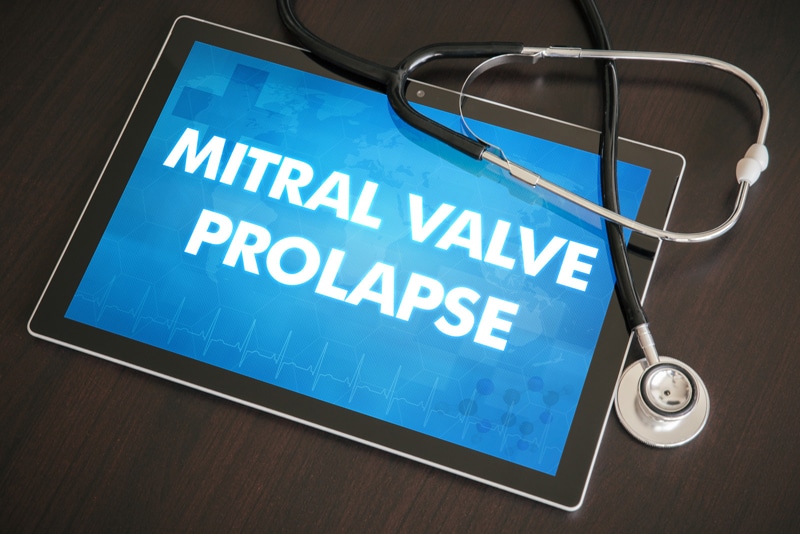Regarded as the most common heart valve abnormality, mitral valve prolapse (MVP) occurs when the flaps (leaflets) of the heart’s mitral valve do not close evenly, but bulge (prolapse) into the heart’s left upper chamber (left atrium). Also known as click-murmur syndrome, Barlow’s syndrome or floppy valve syndrome, the condition affects 3-5 percent of the population. The condition affects females (between 20-40 years) twice as often as males. In MVP, the valve happens to slip backward due to the abnormal size or damage to the mitral valve tissues. For most people, MVP syndrome has a strong hereditary tendency, although the exact cause is unknown. In some cases, it can be caused by other health problems like connective tissue disease. A person can have the genetic risk of developing MVP. In most people, mitral valve prolapse is not life-threatening and therefore does not require any specific treatment. In other cases, people with MVP require adequate treatment and lifestyle changes. Proper documentation is essential to justify medical necessity and selection of codes for billing. Relying on the services of an experienced cardiology medical billing company can help in accurate and timely claim submission to insurers.
Mitral valve prolapse (MVP) affects nearly 8 million people in the United States. The mitral valve is one of the four heart valves that consist of two thin leaflets (shaped like parachutes) that are attached to the inner wall of the left ventricle by a series of strings called “chordae”. Upon contraction of the ventricles, the mitral valve leaflets close tightly and prevent the backflow of blood from the left ventricle into the left atrium. On the other hand, when the ventricles relax, the valves open to allow oxygenated blood from the lungs to fill the left ventricle. If left untreated, the condition can become severe and cause heart failure and abnormal heart rhythms. In most cases, people are unaware of the prolapsing of the valve. However, in other cases, people may experience a number of symptoms.
Identifying the Symptoms of MVP
Chest pain is one of the most common signs. The type and severity of symptoms can vary widely, can be mild and develop gradually, and may differ from person to person. As MVP is a common cause of mitral regurgitation, the condition causes the blood to flow backward through the mitral valve with each heartbeat. Other related symptoms include –
- Swelling in the legs and feet
- Passing out or fainting, known as syncope
- Panic and anxiety
- Numbness or tingling in the hands and feet
- Fluttering or rapid heartbeat called palpitation
- Fatigue
- Dizziness or lightheadedness
- Difficulty breathing or shortness of breath (often during physical activity or when lying flat)
- A racing or irregular heartbeat (arrhythmia)
Mitral valve prolapse can occur at any age. In fact, serious symptoms of mitral valve prolapse tend to occur most often by 50 years (in men). Other severe complications associated with this condition include – mitral valve regurgitation, heart rhythm problems (arrhythmias) and heart valve infection (endocarditis).
How Is Mitral Valve Prolapse Diagnosed and Treated?
As most people with mitral valve prolapse do not experience any specific symptoms, diagnosis is often done through a routine physical examination. The condition may be detected through a “click-murmur sound” which a physician can hear while listening to your heart with a stethoscope during a physical examination. The murmur sound is caused by some of the blood leaking back into the left atrium. In short, the click or murmur may be the only clinical sign.
In addition, other diagnostic imaging tests like – Echocardiography, Transesophageal echocardiography, Cardiac Catheterization, Chest X-ray, Electrocardiogram (ECG), Radionuclide scans, Magnetic resonance imaging (MRI), Coronary angiogram and stress test may also be performed to evaluate your heart condition.
Generally, people with mitral valve prolapse (who do not experience any symptoms) do not require any specific treatment. Physicians in such cases may normally recommend regular follow-up examinations to monitor the condition (depending on the severity of the disease). On the other hand, for people who experience symptoms and if a significant amount of blood is leaking through the mitral valve, physicians may recommend treatment options like medications or surgery. Medications include – beta blockers, heart rhythm medications, blood thinners and water pills (diuretics). Surgery to repair or replace the mitral valve will be suggested for people who have severe mitral regurgitation resulting from a floppy mitral leaflet, rupture of the chordae tendineae, or extreme lengthening of the valve. Valve repair and replacement may be performed using open-heart surgery or minimally invasive surgery. In about 10 to 15 percent of people with MVP, further treatment is required.
Cardiology medical billing and coding can be challenging and involves using the relevant ICD-10 codes as well as the CPT codes on the medical claims submitted to health insurers. Cardiologists or other specialists providing treatment (that involves diagnosis, screening and other tests) for MVP patients must carefully document the diagnosis and treatments using the right medical codes. Billing and coding services offered by experienced medical billing companies can help physicians ensure the correct codes for their medical billing purposes. Medical codes for mitral valve prolapse include –
ICD-10 Codes
- I34 – Nonrheumatic mitral valve disorders
- I34.0 – Nonrheumatic mitral (valve) insufficiency
- I34.1 – Nonrheumatic mitral (valve) prolapse
- I34.2 – Nonrheumatic mitral (valve) stenosis
- I34.8 – Other nonrheumatic mitral valve disorders
- I34.9 – Nonrheumatic mitral valve disorder, unspecified
CPT Codes
- 33418 – Transcatheter mitral valve repair, percutaneous approach, including transseptal puncture when performed; initial prosthesis
- 33419 – Transcatheter mitral valve repair, percutaneous approach, including transseptal puncture when performed; additional prosthesis(es) during same session (List separately in addition to code for primary procedure)
- 0345T – Transcatheter mitral valve repair, percutaneous approach via the coronary sinus
- 0544T – Transcatheter mitral valve annulus reconstruction, with implantation of adjustable annulus reconstruction device, percutaneous approach including transseptal puncture
Although some patients with mitral valve prolapse may experience complications, most have no symptoms and can lead healthy, active, and normal lives. The condition is usually harmless and does not cut down life expectancy. Healthy lifestyle behaviors and regular exercise are encouraged to better prevent and manage the condition in the long run.
Treating and managing patients with MVP can be quite challenging for cardiologists or other physicians. Outsourcing medical billing and coding tasks is a practical option for such physicians to ensure appropriate care for their patients as well as accurate clinical documentation of the valve-disorder.




